
Louis the Pious, also called the Fair and the Debonaire, was King of the Franks and co-emperor with his father, Charlemagne, from 813. He was also King of Aquitaine from 781. As the only surviving son of Charlemagne and Hildegard, he became the sole ruler of the Franks after his father's death in 814, a position that he held until his death except from November 833 to March 834, when he was deposed.

Pope Gregory IV was the bishop of Rome and ruler of the Papal States from October 827 to his death. His pontificate was notable for the papacy’s attempts to intervene in the quarrels between Emperor Louis the Pious and his sons. It also saw the breakup of the Carolingian Empire in 843.
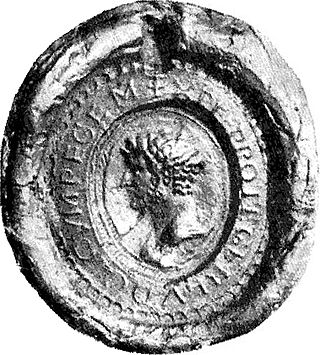
Louis the German, also known as Louis II of Germany, was the first king of East Francia, and ruled from 843 to 876 AD. Grandson of emperor Charlemagne and the third son of Louis the Pious, emperor of Francia, and his first wife, Ermengarde of Hesbaye, he received the appellation Germanicus shortly after his death, when East Francia became known as the kingdom of Germany.

Charles the Bald, also known as Charles II, was a 9th-century king of West Francia (843–877), King of Italy (875–877) and emperor of the Carolingian Empire (875–877). After a series of civil wars during the reign of his father, Louis the Pious, Charles succeeded, by the Treaty of Verdun (843), in acquiring the western third of the empire. He was a grandson of Charlemagne and the youngest son of Louis the Pious by his second wife, Judith.

Hugh Capet was the King of the Franks from 987 to 996. He is the founder of and first king from the House of Capet. The son of the powerful duke Hugh the Great and his wife Hedwige of Saxony, he was elected as the successor of the last Carolingian king, Louis V. Hugh was descended from Charlemagne's son Pepin of Italy through his mother and paternal grandmother, respectively, and was also a nephew of Otto the Great.
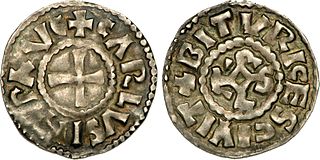
Charles III, called the Simple or the Straightforward, was the king of West Francia from 898 until 922 and the king of Lotharingia from 911 until 919–923. He was a member of the Carolingian dynasty.

The Carolingian dynasty was a Frankish noble family named after Charles Martel and his grandson Charlemagne, descendants of the Arnulfing and Pippinid clans of the 7th century AD. The dynasty consolidated its power in the 8th century, eventually making the offices of mayor of the palace and dux et princeps Francorum hereditary, and becoming the de facto rulers of the Franks as the real powers behind the Merovingian throne. In 751 the Merovingian dynasty which had ruled the Franks was overthrown with the consent of the Papacy and the aristocracy, and Pepin the Short, son of Martel, was crowned King of the Franks. The Carolingian dynasty reached its peak in 800 with the crowning of Charlemagne as the first Emperor of the Romans in the West in over three centuries. Nearly every monarch of France from Charlemagne's son Louis the Pious till the penultimate monarch of France Louis Philippe have been his descendants. His death in 814 began an extended period of fragmentation of the Carolingian Empire and decline that would eventually lead to the evolution of the Kingdom of France and the Holy Roman Empire.

Lotharingia was a medieval successor kingdom of the Carolingian Empire. It comprised present-day Lorraine (France), Luxembourg, Saarland (Germany), Netherlands, most of Belgium, and Germany west of the Rhine. It was named after King Lothair II, who received this territory as his share of the Kingdom of Middle Francia which his father, Lothair I, had held.

Lothair, sometimes called Lothair II, III or IV, was the penultimate Carolingian king of West Francia, reigning from 10 September 954 until his death in 986.

Bruno the Great was the Archbishop of Cologne from 953 until his death and the Duke of Lotharingia after 954. He was the youngest brother of Otto I, Holy Roman Emperor.
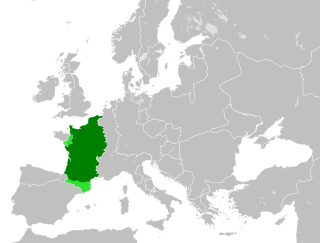
In medieval historiography, West Francia or the Kingdom of the West Franks constitutes the initial stage of the Kingdom of France and extends from the year 843, from the Treaty of Verdun, to 987, the beginning of the Capetian dynasty. It was created from the division of the Carolingian Empire following the death of Louis the Pious, with its neighbor East Francia eventually evolving into the Kingdom of Germany.
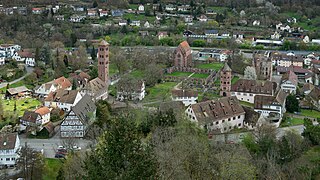
Hirsau Abbey, formerly known as Hirschau Abbey, was once one of the most important Benedictine abbeys of Germany. It is located in the Hirsau borough of Calw on the northern slopes of the Black Forest mountain range, in the present-day state of Baden-Württemberg. In the 11th and 12th century, the monastery was a centre of the Cluniac Reforms, implemented as "Hirsau Reforms" in the German lands by William of Hirsau. The complex was devastated during the War of the Palatine Succession in 1692 and not rebuilt. The ruins served as a quarry for a period of time.
Carloman was the youngest son of Charles the Bald, king of West Francia, and his first wife, Ermentrude. He was intended for an ecclesiastical career from an early age, but in 870 rebelled against his father and tried to claim a part of the kingdom as an inheritance.
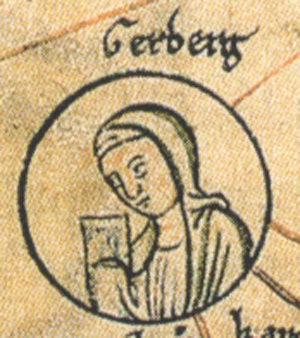
Gerberga of Saxony was a Queen of France by marriage to Louis IV of France between 939 and 954. She ruled as regent of France during the minority of her son Lothair in 954–959.
Gebhard was a mid-9th-century count in the Lahngau and the first documented ancestor of the dynasty later known as the Conradines. He was a "leading man of the [East] Franks" and a brother-in-law of Ernest, margrave of the Bavarian Nordgau. Gebhard may be a son of Odo I, Count of Orléans, if identical with Udo the Elder, count in the Lahngau from 821 to 826.
Hucbert was a Frank and son of the count Boso the Elder. Therefore, he was a Bosonid, and the namesake for the Huberterian branch of the family. His rise to power commenced under Lothair I but continued under Lothair II, reaching its apex when his sister Theutberga married Lothair II, a prince of the Carolingian dynasty, the imperial family of Francia. Hucbert also served as the lay-abbot of the Abbey of Saint Maurice-in-Valais. This gave him control over the Mons Iovis pass, the main route between Francia and Italy. Hucbert later gained power in the region of Transjurane Burgundy (859) which is what helped him later to find safety within the kingdom of Charles the Bald.
Saint Altfrid was a leading figure in Germany in the ninth century. A Benedictine monk, he became Bishop of Hildesheim, and founded Essen Abbey. He was also a close royal adviser to the East Frankish King Louis the German.

Justin the Confessor was a Christian martyr in the Roman Empire. He is honoured as a saint by the Roman Catholic Church.
Gozbald, in Latin Gozbaldus or Gauzbaldus, was the abbot of Niederaltaich from 825, and the bishop of Würzburg from 842, until his death. He also served as chorbishop of the diocese of Passau. On the basis of an entry in the confraternity book of Reichenau Abbey, the historian Gerd Althoff suggests that Gozbald belonged to the Hattonian family.

Louis IV, called d'Outremer or Transmarinus, reigned as King of West Francia from 936 to 954. A member of the Carolingian dynasty, he was the only son of king Charles the Simple and his second wife Eadgifu of Wessex, daughter of King Edward the Elder of Wessex. His reign is mostly known thanks to the Annals of Flodoard and the later Historiae of Richerus.















